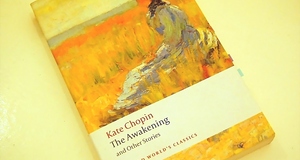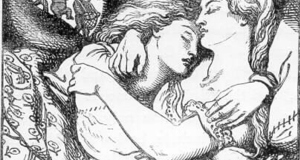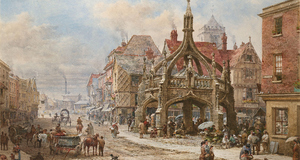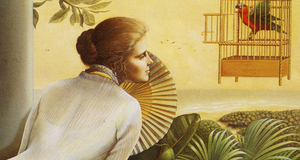The Relevance of Food to Representations of Gender in The Awakening and Goblin Market
By
2010, Vol. 2 No. 02 | pg. 2/2 | « Fox-Genovese argues that The Awakening does not present marriage as the external symbol of female identity formation,’ (1994:258) and indeed I would agree; the meal has made her an equal of her husband, it has acted to shape her identity, and to change her position in the gender hierarchy. After the meal she is able to leave the house, she is no longer confined by the old patriarchy, but is free and independent. Further to this, we see again further emphasis on providing for the self with regards to Edna’s appetite and increased consumption, both of which change, and with this comes a change in her physical appearance, which acts to mirror her changing identity. As she distances herself from her husband, we find Edna to be often ‘hungry’ (1994:60) ‘very hungry’ (1994:36) or ‘hungry again.’ (1994:72) One might argue that this is in fact an indication that the male provider is needed, that Edna is incapable of satisfying her consumptive needs without her husband. However, coupled to this is increased consumption of food and a change in her body dimensions, a she is described throughout the novel as having put on wait, for example her chin ‘was growing a little full and double.’ (1994:79) Thus it is clear she is capable of providing for herself amply, even more than her husband could it might seem.I instead believe this all lies in a rejection of the traditional female identity in favour of her own personal identity. Typically, a woman will increase in size when she becomes pregnant. Whilst Edna is herself already a mother, she is described as ‘not a mother woman.’ (1994:9) Instead, her later changing in size is the result of sensual enjoyment, rather than the fulfilment of a traditional female role, the role of the mother. The food, may well be representative of sex. Counihan argues that ‘food and sex are analogous instinctive needs [and…] are metaphorically overlapping.’ (1999:63) I believe this is certainly the case in The Awakening. Wolkenfeld argues that ‘the fact Edna is ‘very hungry’ reflects her longing for a new life of sensuous satisfaction.’ (1994:245) This all links to her increased sexual awareness, and the development of her own identity free from the imposed gender roles. Her size changes because of an increased urge for sensual pleasure, not to fulfil the role of mother, a role she does not feel is part of her identity. To this end, I would suggest that increased desire for consumption of food mirrors her increased sexual awareness, and acts to physically illustrate her shifting identity, which moves away from traditional female roles towards her true self. There is however one core element to traditional female identity that is not challenged in The Awakening in my opinion, but affirmed, and that is the relationship with Eve. I find the fact that Edna paints apples (1994:56) to be particularly relevant, as it is impossible to consider women and apples together without thinking of Eve. I believe therefore her painting apples is intended make us associate Edna with Eve. This is explored further at the close of the novel; George Spangler argues that the ending is ‘a conclusion for an ordinary sentimental novel, not for a subtle psychological treatment of female sexuality.’ (1994:209) This notion I entirely reject, and will argue here that the end of the novel in fact is a subtle affirmation of female sexual identity. I feel it necessary first to explain briefly how Chopin establishes the parallel with Eve before I can make my central point. The fact that as she stands in the sea with ‘the foamy wavelets curled up to her white feet, and coiled like serpents about her ankles,’ (1994:109) immediately makes the reader associate the scene with the story of the garden of Eden. Subsequently, Chopin, for me, offers a rewriting of the end of Paradise Lost, with the female leaving paradise alone, and perhaps relevantly ‘she did not look back now’ (1994:109) on what she is leaving, as Adam and Eve do at the end of Paradise Lost, ‘They, looking back, all th’ eastern side beheld / Of Paradise.’ (Milton, 2005:303) Edna can then make her way in a kind of new world, relevantly, alone. But I feel the most relevant phrase in the entire sequence is ‘how strange and awful it seemed to stand naked under the sky! How delicious!’ (1994:109) This obviously mirrors Eve’s realisation she is naked after eating the fruit, however, the fact that Chopin describes this as ‘delicious’, and ascribes a food quality to the event, also recalls the actual eating of the fruit. The effect of the word delicious, in this context, I believe affirms her identification with Eve, it affirms her decision to eat the fruit for the sensual rewards it brought. This again not only shows the absolute link between food and sex/sexuality, but also acts to congratulate Eve to a degree, rather than condemn her for her eating the fruit. Inevitably, this then affirms Edna’s actions in her state as a fallen woman. Wolkenfeld stresses that our interpretation of ‘the tone of the narrative voice’ (1994:242) impacts on our reading of the ending, and it is words like ‘delicious’ that, to me, make the end affirmative, make this a celebration of female sexuality and sensual identity, not a mere sentimental ending. The relevance and identification with Eve in Goblin Market is, I feel, slightly more ambiguous however. There can be little doubt the Laura acts as an Eve figure, as she becomes fallen after eating of ‘the fruit forbidden.’ (2006:1476) But it is much trickier to place Lizzie in relation to Eve, many critics choosing not to. Vejueda argues that ‘a common interpretation of the poem is to see Lizzie as Christ and Laura as a figure for fallen humanity. But the twin imagery used to describe the sisters suggests that either one has the potential to be fallen and to be redeemed.’ (2000:573) She goes on to present the ‘notion that if female experience leads to falleness, then perhaps female experience can also point the way to redemption.’ (2000:574) Whilst I am inclined to agree with her first statement, I feel the second is entirely contrary to what occurs in the poem, rather it is female inexperience which redeems. One element of the poem that, as far as I am aware, has been completely overlooked is the fact that Laura asks Lizzie ‘have you tasted / For my sake the forbidden fruit?’ and wonders if Lizzie will be ‘ruined in my ruin.’ (2006:1476) To this, Lizzie makes no response, and of course the whole point of the previous scene was that Lizzie had not tasted the fruit, and she had taken a beating for it. As such, when Lizzie becomes the food herself to her sister (as mentioned above) she becomes rather than the fruit of experience, the fruit of innocence. When Laura awakes she ‘laughed in the old innocent way,’ (2006:1477) the act of eating Lizzie has negated the effect of the goblins fruit. This could lead us clearly to regard Lizzie as Christ, indeed Gilbert and Gubar argue that Lizzie ‘offers herself to be eaten and drunk in a womanly holy communion.’ (2005:566) This seems to make sense, but I believe the fact that Lizzie asks Laura to ‘suck my juices’ and that she is ‘bruised’ (2006:1476) as a fruit would be, force us to relate her more to the garden of Eden than Christ. To this end, I believe the end here works not like the awakening to affirm the connection with Eve, but to at accept. Some women will fall like Eve, yet they should still be loved, and the relationship between women – not the relationship between men and women – is the strongest, most morally correcting relationship there is. Adam was only capable of falling to the level of Eve, Rossetti present effectively Eve’s sister as being capable of raising the fallen woman back to paradise. To this end, I would argue that both Rossetti and Chopin present challenges to the gender hierarchy by presenting women who are capable of providing food for themselves, and in a position to reject offers of provision from the men. In Chopin’s case, her character Edna is concerned solely with providing for herself and affirming her own identity free of traditional gender roles, whilst Rossetti acts to affirm the natural strength of the female through her role as the maternal provider. The prevalence of fruit in the two novels I believe to be part of a wider engagement with the nature of female identity in relation to Eve, where both writers highlight a positive link to their earliest ancestor, rather than a condemnation. ReferencesCasey, Janet Galigani, 1991. The Potential of Sisterhood. Victorian Poetry 29 (1) pp 63-78 Chopin, Kate, 1994. The Awakening, ed. Margo Culley. New York: W.W. Norton & Company. Couhnihan, Carole, 1998 ‘Introduction - Food and Gender: Idenity and Power’ in Food and Gender: Identity and Power, ed. Carole Couhnihan. Amsterdam: OPA. Pp. 1-11 Counihan, Carole, 1999. The Anthropology of Food and Body. London: Routledge. Casey, Janet Galligani, 1991. The Potential of Sisterhood: Christina Rossetti’s ‘Goblin Market’. Victorian Poetry 29 (1) pp. 63-78 Fox-Genovese, Elizabeth, 1994. ‘Progression and Regression in Edna Pontellier in The Awakening, ed. Margo Culley. New York: W.W. Norton & Company Inc. Pp. 257-263 Gilbert, Sandra M. and Gubar, Susan, 2000. The Madwoman in the Attic: The Woman Writer and the Nineteenth Century Literary Imagination, second edition. London: Yale University Press Milton, John, 2005. Paradise Lost. New York: W.W. Norton & Company Inc Rossetti, Christina, 2006. Goblin Market in The Norton Anthology of English Literature, Eighth Edition, ed. Stephen Greenblatt. New York: W.W. Norton & Company Inc. Pp. 1466-1478 Spangler, George M., 1994. ‘The Ending of the Novel’ in The Awakening, Ed. Margo Culley. New York: W.W. Norton & Company Inc. Pp. 208-211 Vejvoda, Kathleen, 2000. The Fruit of Charity: “Comus” and Christina Rossetti’s “Goblin Market.” Victorian Poetry. 38 (4) pp. 555-578 Wolkenfeld, Suzanne, 1994. ‘Edna’s Suicide: The Problem of the One and the Many’ in The Awakening, ed. Margo Culley. New York: W.W. Norton & Company Inc. Pp. 241-247 Suggested Reading from Inquiries Journal
Inquiries Journal provides undergraduate and graduate students around the world a platform for the wide dissemination of academic work over a range of core disciplines. Representing the work of students from hundreds of institutions around the globe, Inquiries Journal's large database of academic articles is completely free. Learn more | Blog | Submit Latest in Literature |


















